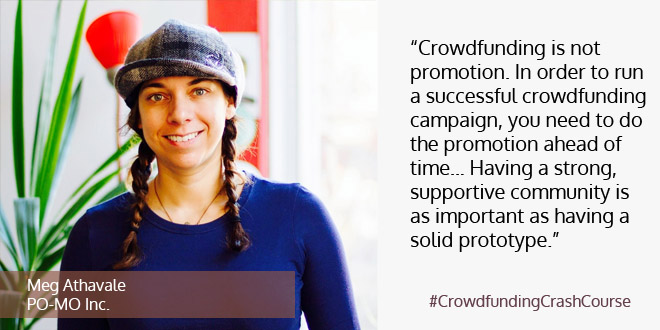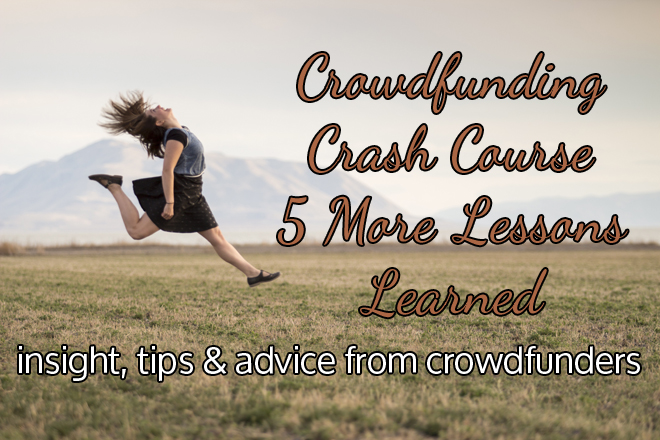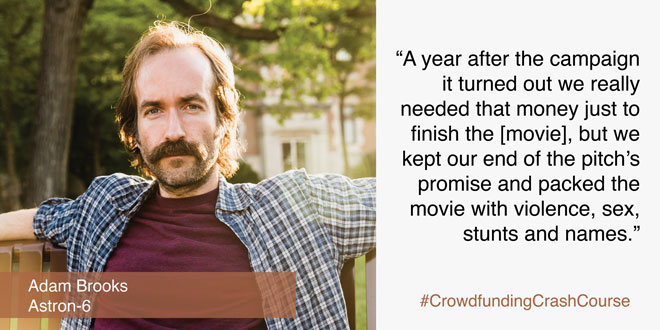Tagged: indiegogo
Crowdfunding Crash Course: 5 More Lessons Learned
- by Alyson Shane
The Crowdfunding Crash Course is chugging along and I'm amazed at the overwhelming response from participants and readers alike - I'm learning so much, and am loving the journey of sharing interesting and innovative projects with all of you.
With that in mind, let's review some of the key themes that have emerged over the responses so far and see what we've learned:
1. Organize your team before you start
Kelly Stacey of SoLight, who funded their product SolarPuff on Kickstarter, mentioned that keeping up-to-date with backer questions and special requests was especially taxing. "We had a lot of people asking a lot of questions and getting back to all of them (and we did) was very time consuming" she says, and she isn't alone: every single person I've interviewed has mentioned the tremendous level of organization required to run a successful campaign.
Randy Hoyt, who successfully funded two tabletop games, Relic: Expedition and Lanterns: The Harvest Festival on Kickstarter, took the first and last day off work to make sure that he was available to handle all questions and issues that might come up. "The first and last days of your campaign are the busiest" he says.
The takeaway: if you don't feel like you can handle the planning and execution of your campaign, hire someone or organize a team of people to help you with it. Even things as seemingly simple as responding to backer emails, or interview questions can take up a lot of time, and by delegating and being organized you can make sure you're focusing on what matters: making sure your project is fully funded.
2. Tap into your existing audience
Randy Hoyt from Foxtrot games use the momentum from their first tabletop game, Relic: Expedition to build momentum for their next game Lanterns: The Harvest Festival. They had an existing mailing list from the first Kickstarter which they used to spread the word to people who they already knew were interested in tabletop games, and who had already helped fund the earlier project. Meg from Po-Mo, who funded the interactive projector Lumo on Indiegogo, also tapped into her existing email list to spread the word about their campaign.
When Nils Karlen launched his Kickstarter for Simon Stålenhag's two art books Tales from The Loop and Swedish Machines, Lonely Places, he knew that Simon already had a tremendous following online that they could tap into in order to get funding. Fria Ligen used their own networks to promote the project, but what put them over the top was that Simon leveraged his social media channels and his Tumblr to promote it.
The takeaway: if you have an existing audience, or are working with someone who does, reach out to those people first and let them know about your project. If you don't, spend the time before you launch to build an email list, Facebook page, and Twitter following so that people across multiple social channels can stay up-to-date with your progress.
3. Turn funders into contributors
During his first Kickstarter for Relic: Expedition, Randy Hoyt was hesitant to share the script and rough storyboard for the video with his audience. The second time around, he says, he "realized that feedback was so important" and posted the rough storyboard on YouTube and shared it on Twitter and Facebook so that he could get people's feedback. He also allowed backers to vote on different variations of artwork for Lanterns: The Harvest Festival, which increased engagement and excitement about the project.
The takeaway: By offering backers the opportunity to give their input on things like artwork and design you give them an added incentive to back your campaign: not only are they getting a cool product if your campaign meets its goals, but they also get to participate in the creation of something that interests them.
4. Plan your pledge levels for greater success
Nils Karlen mentioned that during his research for Simon's books that they found that having a very low pledge level (a dollar or two) was an important step to get the campaign started because Kickstarter's metrics consider ever pledge, no matter how big or small.
They also used early bird pledges to incentivize people to start donating early (an early bird pledge is a limited pledge level that is strictly better in terms of price than a comparable level.) By offering limited-time options it mobilizes backers early on, and it also gives you opportunities to promote the campaign by appealing to this sense of urgency eg: "only two more days of our Early Bird $10 option!"
The takeaway: It might seem tempting to only offer pledges at higher dollar values because it will feel like getting closer to your goal faster, but remember that everyone who contributes to your campaign will likely spread the word about it, as well, and you don't want to alienate potential backers by only offering expensive options. Try to create a pledge system with rewards and dollar amounts that appeal to everyone.
5. Don't get discouraged
There will be slow days, no-news days, and days when everything feels as though it's come to a grinding halt. This is normal. What's important is to stay motivated and think realistically, and use those "down" days as days to find other ways to stay motivated and positive about your project.
Tamar Swartz, who used Indiegogo to fund her project Journey to Creative Surrender, mentioned in her interview that she had to remind herself that contributions come in waves, and just because there's a lull doesn't mean that there's a reason to get discouraged, and Mike Raven mentioned in his Traveling Book interview that he also struggled to stay motivated in between donations.
The takeaway: Don't let a slow day get you down! It's totally normal to get stressed out or feel anxious if your project isn't funded within the first few days, but as long as you stick to your promotional schedule and continue to do things like respond to emails, send out updates and stay active on social media you'll soon see another surge of backers.
This post is part of the #CrowdfundingCrashCourse series. You can find the entire series of interviews and summary posts here.
Crowdfunding Crash Course: Meghan Athavale of POMO Inc - Lumo Play
- by Alyson Shane

Meghan Athavale is an entrepreneur and artist. She is the co-founder and CEO of Po-Motion (PoMo) Inc and Lumo Play.
She is currently running an Indiegogo campaign to crowdfund the LUMO Interactive Projector.
Can you briefly describe Lumo?
Lumo is a turnkey gaming and display system that includes a projector, a sensor that captures motion data, and an Android processor. It projects games you would normally play on a touchscreen onto the floor of a child’s playroom, so they can play by jumping, moving, waving their arms and running. It also works as a regular projector, so you can play movies with it, and non-motion reactive games (using a bluetooth controller.) Finally, Lumo has an online content creation suite designed so that young children can customize games using their own artwork.
Why did you feel that the crowdfunding model was the best way to promote Lumo?
We’ve been seeking investment for Lumo for about a year. It’s tough to get investment for hardware, and even tougher if your company is based in a place with very little access to VC communities. VCs only fund about 1% of the deals they see. Here’s a great article explaining why: http://www.startupcfo.ca/2012/08/top-10-signs-your-business-is-not-vc-fundable/
Lumo doesn’t have traction yet, because it isn’t for sale yet. It’s not for sale because we need funding to produce it. We know people want it, but we don’t know how many people want it yet. Crowdfunding, in our case, is a great way to allow our market to tell us what they want in terms of features and price point, without the risk of spending hundreds of thousands of dollars producing a bunch of Lumos first.
Having said that, crowdfunding is not promotion. In order to run a successful crowdfunding campaign, you need to do the promotion ahead of time. We learned that when our first attempt on Kickstarter failed epically.
Why and how did you choose Indiegogo over other crowdfunding options available?
We did Kickstarter in September 2013 with a very very early stage prototype and no marketing. It still raised around $25,000, but it wasn’t enough to move the project forward, so we regrouped and joined a 4 month incubator, visited China, and hired some engineers.
We’re now launching on Indiegogo for two reasons. 1) they have a partnership with the hardware incubator we attended, so we got a lot of support regarding pre-campaign prep and marketing for our upcoming launch (we couldn’t even get a contact email from Kickstarter) and 2) The flexible funding option makes sense for us right now. We can make 10 Lumos or we can make 10,000 Lumos, depending on market demand. We don’t have to meet our goal to move forward. That wasn’t the case in 2013.
How big was your budget before you launched your crowdfunding campaign?
The first campaign had no budget. In total we’ve spent around $5000 in marketing activities this time. This includes attending SXSW, running facebook ads, and running a contest using a tool called Gleam.
How far along was your project before you felt ready to launch a crowdfunding campaign? In hindsight, would you have preferred to be farther along, or to have crowdfunded earlier?
The first campaign, on Kickstarter, wasn’t nearly far enough along. In retrospect I would have waited until we had a prototype that was only a few steps from DFM (design for manufacturing). We have that now.
More importantly, though, I wish I’d spent a year reaching out to people and building a community before launch. Having a strong, supportive community is as important as having a solid prototype.
Can you explain how you prepared for and managed your campaign?
The first campaign was a one-person show. I had some help making a few games and shooting the video, but overall the whole thing was my personal learning experience. This time we have a delegation process. Someone is in charge of the video. Someone else is in charge of design. I am in charge of PR and marketing, and the developers can focus on making the thing work.
What tools did you use to market your campaign?
I only used social media and local news coverage on my last launch. We managed to get a big spread story in the Globe and Mail that went out a week before our campaign went live.
This year I used Gleam, Thunderclap, fb ads, and attended a pile of events and conferences. I also believe in old-school hustle, so I invite parents and families in the Los Angeles area to come hang out with me and play with Lumo. The best way to build supporters is to actually show them your product and meet them in person, I find.
What was your biggest challenge during your campaign? What could you have done differently?
The biggest challenge with the Kickstarter was exposure. We also didn’t really know what our marketing message was at that point.
I think the biggest challenge on the upcoming campaign will be keeping up with correspondence. We are already getting tons of calls and emails, and there’s really only two people on hand to answer them.
We have a list of over 30 people on standby to help us if we need them.
In retrospect what were your best assets for running your original campaign? Since you’re launching another campaign soon, how do you plan to apply these lessons this time?
The best thing we did with our original campaign was saving the email list and keeping up with the original community. They are our biggest advocates, since they know how far we’ve come.
What’s the most valuable advice you could share with aspiring crowdfunders?
Keep a very open mind, spend as much time as possible building an email list, and don’t be afraid to ask for help. You are about to ask hundreds of strangers for their money. You should get used to defending yourself in the nicest possible way, which means you will have to talk to hundreds of people before you launch to get your messaging and language right.
If your campaign isn’t going well, shut it down and try again later. If you let it run it’s course and fail, you will have a dead skeleton of a kickstarter haunting the interwebz for all eternity (like we do). It’s totally okay to shut down early, regroup, and try again. Your community will understand. They want you to succeed.
This post is part of the #CrowdfundingCrashCourse series. You can find the entire series of interviews and summary posts here.
Crowdfunding Crash Course: Adam Brooks of Astron-6 - The Editor
- by Alyson Shane
Adam Brooks is an actor, writer and founding member of Astron-6, a Winnipeg-based film production company. They used Indiegogo to crowdfund their film The Editor.
Can you briefly describe The Editor?
Yep. It’s an absurdist giallo movie about a film editor suspected of murdering a number of his co-workers in a film studio in the late 1970s.
Why did you feel that the crowdfunding model was the best way to promote the film?
Because it required the least investment for the highest gain - nothing to lose.
Why and how did you choose Indiegogo over other crowdfunding options available?
I didn’t spend much time researching it but they seemed to keep a smaller chunk for themselves than their competition.
How big was your budget before you launched your crowdfunding campaign?
$120k.
How far along was your project before you felt ready to launch a crowdfunding campaign? In hindsight, would you have preferred to be farther along, or to have crowdfunded earlier?
It’s a bit of a long and boring story - we had started to shoot ‘The Editor’ as a fake trailer on SLR and eventually decided we might as well try to make an actual feature out of it. We wrote a script and applied for telefilm’s microbudget program.
Can you explain how you prepared for and managed your campaign?
We brainstormed a list of rewards minutes before taping the pitch video and then uploaded it to indiegogo and posted it all over our social media.
What tools did you use to market your campaign? Do you feel like you did so successfully, and if not, what could you have done differently?
We've built a small audience already, so all the blogs that had previously taken an interest in our material were happy to post the indiegogo without us asking.
I think it was successful - we exceeded our goal.
In retrospect what were your best assets for running this successful campaign? On the other hand, what would you do differently?
I think you need a cool project, and cool rewards…. I really wish I’d budgeted all the postage I’ve had to spend on the rewards though or budgeted to pay somebody to do it for me.
What was your biggest challenge during your campaign?
I don’t know. We already had $120k. Our campaign was just trying to get us an additional $16k to punch up what we already had. A year after the campaign it turned out we really needed that money just to finish the thing, but we kept our end of the pitch’s promise and packed the movie with violence, sex, stunts and names.
What’s the most valuable advice you could share with aspiring crowdfunders?
Make a comic with the Soskas.
This post is part of the #CrowdfundingCrashCourse series. You can find the entire series of interviews and summary posts here.


